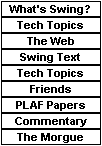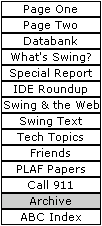 |
||||||
 |
||||||
|
|
||||||
 |
||||||
|
||||
|
The JTable Class in JFC 1.1 By Philip Milne By stripping away what wasn't needed and holding on to the rest, the Swing team has come up with a lean, mean JTable class that makes it easy to create, manage, and optimize tables using Swing.
Consequently, developers who have written JTable code using early-access versions of Swing will probably have to do some revising when they start migrating their JTable code to the latest version of Swing. This article provides some tips on handling challenges you may encounter when you start developing programs using the turbocharged version of the JTable class that made its debut in Version 1.0 of Swing. Most of these tips are presented in the form of text files that have not yet been fashioned into Web pages. Later in this article, you'll find links to these accompanying text files. A number of the topics covered in these files will be addressed in greater detail in future issues of The Swing Connection. Meanwhile, though, the information they contain is so important that we have provided them here in their original form.
Apart from one rather sweeping change -- specifically, a formal separation of the JTable class and the DefaultTableModel -- the JTable modifications in Version 0.7 for the most part are syntactic. There have been no changes to the fundamental architecture, which seems during the development of Swing to have worked well in most situations. But we have made a number of internal changes that will let the various parts of the table package communicate more directly with one another, resulting in better performance. With this release, all significant bottlenecks that had reduced JTable's efficiency in working with large tables appear to have been been removed, and JTable's operations have been streamlined so extensively that very little processing time is spent inside the JTable machinery during rendering. And improvements keep coming: The next phase of JTable optimization will usher in some specialized renderers that should make scrolling through large tables of simple types much faster. When all these changes are complete, we believe the result will be a table component that can serve both as a practical and efficient front end for database-like applications and as a framework for creating much more elaborate interfaces using the many customizable parts of the JTable's design.
We decided to perform surgery on the JTable API after feedback from developers revealed several areas that appeared to be causing problems. The text files provided with this article describe the modifications that were made in the JTable class as a result of this developer feedback. Included too is a porting guide that provides tips on modifying existing code to work with the newly rewritten JTable API. In covering these topics, the text files supplied with this article (listed in the next section, "Links to the text files") address the following issues:
The text files provided with this article explain exactly what the Swing team did to improve JTable in Version 0.7 of Swing, and exactly why everything was done the way it was. If you would like to know how to modify your code to work with the new JTable API -- but aren't interested in all the details of the changes made and why -- you can navigate straight to the Porting.txt file, which supplies some tips on updating existing code to work with the new API. If you're interested in the nitty-gritty, you might want to browse some of the other text files. Here's what those files contain:
The decision to make sweeping changes in the JTable API at this late stage was not taken lightly. One factor that helped persuade Swing's designers to forge ahead was the concern that the functionalities of the JTable class were beginning to expand the JTable class into a class that resembled a spreadsheet or data-repository mechanism, which is not what JTable was intended to be. In Version 0.7, the Swing team decided to settle on a clear definition of JTable's primary function -- specifically, to provide an editable view of tabular data -- and to draw a clear boundary around JTable to ensure that there would be no further attempts to provide any other other kinds of table functionalities from inside the Swing code base. By abandoning all attempts to find JTable solutions to the kinds of problems that JTable was not suited for, Swing's creators felt that they would be able to focus more intently on improving the efficiency and quality of the JTable as a UI component whose primary task is to provide an editable view of tabular data. |
 Much
of the streamlining of the JTable class took place during the final
stages of the development of Swing, and we found that we had to
add quite a few features and capabilities that were not backwards-compatible
with previous early-access versions of the JTable class.
Much
of the streamlining of the JTable class took place during the final
stages of the development of Swing, and we found that we had to
add quite a few features and capabilities that were not backwards-compatible
with previous early-access versions of the JTable class.